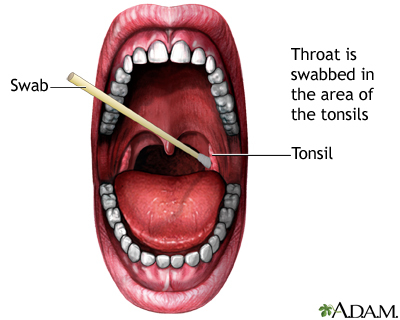Streptococcal screen
Definition
A streptococcal screen is a test to detect group A streptococcus. This type of bacteria is the most common cause of strep throat.
Patient Education Video: Strep throat
Alternative Names
Rapid strep test
How the Test is Performed
The test requires a throat swab. The swab is tested to identify group A streptococcus. It takes about 7 minutes to get the results.
How to Prepare for the Test
There is no special preparation. Tell your health care provider if you are taking antibiotics or have recently taken them.
How the Test will Feel
The back of your throat will be swabbed in the area of your tonsils. This may make you gag.
Why the Test is Performed
Your provider may recommend this test if you have signs of strep throat, which include:
- Fever
- Sore throat
- Tender and swollen glands at the front of your neck
- White or yellow spots on your tonsils
Normal Results
A negative strep screen most often means group A streptococcus is not present. It is unlikely that you have strep throat.
If your provider still thinks that you may have strep throat, a throat culture will be done in children and adolescents.
What Abnormal Results Mean
A positive strep screen most often means group A streptococcus is present and confirms that you have strep throat.
Sometimes, the test may be positive even if you do not have strep. This is called a false-positive result.
Risks
There are no risks.
Considerations
This test screens for the group A streptococcus bacteria only. It will not detect other causes of sore throat.
Gallery


References
Allen CT, Nussenbaum B, Merati AL. Acute and chronic laryngopharyngitis. In: Flint PW, Francis HW, Haughey BH, et al, eds. Cummings Otolaryngology: Head and Neck Surgery. 7th ed. Philadelphia, PA: Elsevier; 2021:chap 61.
Bryant AE, Stevens DL. Streptococcus pyogenes. In: Bennett JE, Dolin R, Blaser MJ, eds. Mandell, Douglas, and Bennett's Principles and Practice of Infectious Diseases. 9th ed. Philadelphia, PA: Elsevier; 2020:chap 197.
Stevens DL, Bryant AE, Hagman MM. Nonpneumococcal streptococcal infections and rheumatic fever. In: Goldman L, Schafer AI, eds. Goldman-Cecil Medicine. 26th ed. Philadelphia, PA: Elsevier; 2020:chap 274.
Tanz RR. Acute pharyngitis. In: Kliegman RM, St. Geme JW, Blum NJ, Shah SS, Tasker RC, Wilson KM, eds. Nelson Textbook of Pediatrics. 21st ed. Philadelphia, PA: Elsevier; 2020:chap 409.